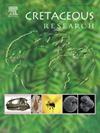Ammonoids and inoceramid bivalves from the Upper Cretaceous shallow marine deposits of Taneichi Formation in Hirono Town, Iwate Prefecture, northeastern Japan: Implication for biostratigraphy
IF 1.7
3区 地球科学
Q1 GEOLOGY
引用次数: 0
Abstract
We examined 47 specimens of ammonoid and inoceramid bivalves from the Cretaceous Taneichi Formation in Iwate Prefecture, northeastern Japan and assigned them to seven species of ammonoids and two species of inoceramids. Of these, five species of ammonoids, Protexanites (Anatexanites) fukazawai (Yabe and Shimizu, 1925); Eubostrychoceras valdelaxum Aiba, Yamato, Kurihara, and Karasawa, 2017; Hyphantoceras transitorium Matsumoto, 1977; Polyptychoceras yubarense (Shimizu, 1935); and Po. obatai (Matsumoto, 1977); and one species of inoceramid, Platyceramus japonicus (Nagao and Matumoto, 1940) are reported for the first time from this Formation. The inoceramid Pl. japonicus and a few biostratigraphically informative ammonoids indicate that the middle Member of the Taneichi Formation was deposited in Santonian–early Campanian (Late Cretaceous). Ammonoid species found in the Taneichi Formation were generally similar to those of the Santonian–lower Campanian in other regions of the northwestern Pacific. Heteromorph taxa were the most abundant ammonoids, accounting for approximately 70 % of the total. Additionally, it is notable that “Leiostraca” taxa, such as Tetragonitoidea and Desmoceratoidea, were not included in the examined specimens. These patterns of occurrence might suggest the palaeoecology of ammonoids, but determining whether they reflect the true distribution requires verification of taphonomic processes, such as post-mortem drifting.

日本东北部岩手县广野镇上白垩统谷一组浅海沉积中的菊石类和双壳类:生物地层学意义
摘要对日本东北部岩手县白垩纪谷一组的47个菊科双壳类和双壳类标本进行了研究,并将其归属于菊科7种和双壳类2种。其中,五种菊石,原石岩(Anatexanites) fukazawai (Yabe and Shimizu, 1925);Eubostrychoceras valdelaxum Aiba, Yamato,栗原和Karasawa, 2017;Hyphantoceras transitorium Matsumoto, 1977;polytychoceras yubarense(清水,1935);和阿宝。obatai(松本,1977);该组中首次报道了一种鱼科植物Platyceramus japonicus (Nagao and Matumoto, 1940)。菊石Pl. japonicus和少量生物地层学资料表明,Taneichi组中段沉积于晚白垩世圣东—早坎帕尼亚期。在Taneichi组中发现的类氨物种与西北太平洋其他地区的圣东统-下坎帕尼亚统的类氨物种大致相似。异型类群中菊石种类最多,约占总数的70%。此外,值得注意的是,“Leiostraca”分类群,如Tetragonitoidea和Desmoceratoidea,没有包括在检查的标本中。这些发生模式可能暗示了菊石的古生态学,但要确定它们是否反映了真实的分布,需要对埋藏学过程进行验证,例如死后漂流。
本文章由计算机程序翻译,如有差异,请以英文原文为准。
求助全文
约1分钟内获得全文
求助全文
来源期刊

Cretaceous Research
地学-地质学
CiteScore
4.10
自引率
19.00%
发文量
235
审稿时长
12 weeks
期刊介绍:
Cretaceous Research provides a forum for the rapid publication of research on all aspects of the Cretaceous Period, including its boundaries with the Jurassic and Palaeogene. Authoritative papers reporting detailed investigations of Cretaceous stratigraphy and palaeontology, studies of regional geology, and reviews of recently published books are complemented by short communications of significant new findings.
Papers submitted to Cretaceous Research should place the research in a broad context, with emphasis placed towards our better understanding of the Cretaceous, that are therefore of interest to the diverse, international readership of the journal. Full length papers that focus solely on a local theme or area will not be accepted for publication; authors of short communications are encouraged to discuss how their findings are of relevance to the Cretaceous on a broad scale.
Research Areas include:
• Regional geology
• Stratigraphy and palaeontology
• Palaeobiology
• Palaeobiogeography
• Palaeoceanography
• Palaeoclimatology
• Evolutionary Palaeoecology
• Geochronology
• Global events.
 求助内容:
求助内容: 应助结果提醒方式:
应助结果提醒方式:


